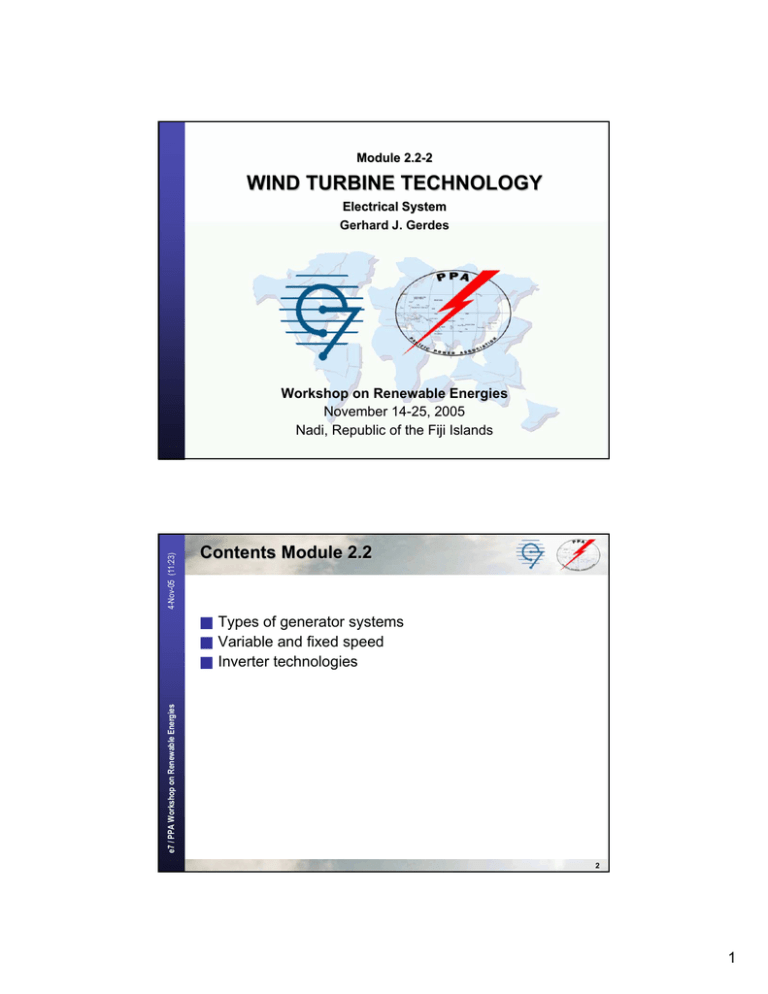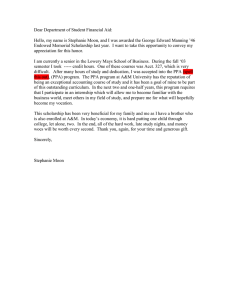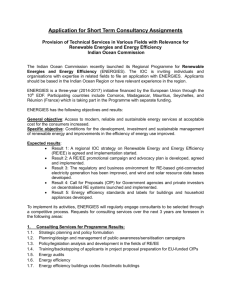Wind Turbine Technology – Electrical System
advertisement

Module 2.22.2-2 WIND TURBINE TECHNOLOGY Electrical System Gerhard J. Gerdes 4-Nov-05 (11:23) Workshop on Renewable Energies November 14-25, 2005 Nadi, Republic of the Fiji Islands Contents Module 2.2 J J e7 / PPA Workshop on Renewable Energies J Types of generator systems Variable and fixed speed Inverter technologies 2 1 4-Nov-05 (11:23) e7 / PPA Workshop on Renewable Energies Types of generator systems Converter type Application induction (asynchronous) generator applied in a large number of turbines (Danish type) synchronous generator only used for a small number of small wind turbines, mainly for stand alone systems asynchronous or synchronous generator with electronic inverter system a widely used concept for variable speed machines, increasing applications with growing size of wind turbines 4-Nov-05 (11:23) 3 Generator concepts of today’ today’s commercially available turbines 16 number of different types e7 / PPA Workshop on Renewable Energies 14 one speed two speed variable speed 12 10 8 6 4 2 0 30 kW - <500 kW 500 kW - <1MW 1 MW - 2 MW 4 2 4-Nov-05 (11:23) Wind turbine with Induction Generator, direct coupled to the grid rotor Gear box induction generator transformer main switch contactor ASG fuse e7 / PPA Workshop on Renewable Energies grid rotor speed thyristor starter compensation pitch or stall Electr. quantities wind speed system management Control SG = synchronous generator, ASG = induction generator e7 / PPA Workshop on Renewable Energies 4-Nov-05 (11:23) 5 Typical induction generator (squirrel-cage) 1 2 3 4 5 shaft ball bearings rotor aluminium sticks aluminium ring (4,5: squirrel-cage) 6 stator nuts with coils 7 stator 8 casing 9 coils of stator 10 ventilator 11 connection box Squirrel-cage 6 3 e7 / PPA Workshop on Renewable Energies 4-Nov-05 (11:23) e7 / PPA Workshop on Renewable Energies 4-Nov-05 (11:23) 2 pole and 4 pole generator Rotating field 7 2 pole and 4 pole generator Rotating field 8 4 4-Nov-05 (11:23) e7 / PPA Workshop on Renewable Energies Synchronous Generator Speeds (rpm) Pole number 50 Hz 2 3000 4 1500 6 1000 8 750 10 600 12 500 J J 60 Hz 3600 1800 1200 900 720 600 a larger number of poles means a lower rotational speed and thus lower gear box ratio but it means also a larger dimension of the generator and more weight 4-Nov-05 (11:23) 9 Synchronisation of a.c. machines J synchronous machines can only be connected to the grid, when X frequency X phase position e7 / PPA Workshop on Renewable Energies X and voltage J are the same induction generators do not have to be synchronised synchronisation 10 5 4-Nov-05 (11:23) Induction generator J advantages: X cheap construction, no collector, no brushes X very low maintenance e7 / PPA Workshop on Renewable Energies X no synchronisation J disadvantages: X requires an external 3-phase grid, no own grid building capability X requires reactive power (usually compensated by capacitor banks) X no voltage control e7 / PPA Workshop on Renewable Energies 4-Nov-05 (11:23) 11 Wind turbine with induction (asynchronous) generator J rotational speed: fixed rotational speed plus slip (~ 2 %) J grid coupling: rigid, with low elasticity J excitation: by the grid J control: power control by stall or active stall (also pitch in case of small turbines) speed control by grid frequency J advantage: simple and cheap construction, lower maintenance standard (stall) no synchronisation with the grid required J disadvantage: production of reactive power, generation of power peaks, only low compensation of wind speed fluctuations, power generation not controllable (stall) 12 6 4-Nov-05 (11:23) Torque diagram – grid connected Mp: pull-out torque e7 / PPA Workshop on Renewable Energies linear torque function under normal operation range e7 / PPA Workshop on Renewable Energies 4-Nov-05 (11:23) 13 Induction generator for wind turbines for a better matching of the torque characteristic of an induction generator to that of a wind turbine (rotor) one can: J vary the resistance of the rotor windings J vary applied grid voltage J use pole changing induction machines (i.e. two speed) J use a frequency converter with a squirrel-cage induction generator J use a frequency converter with a slip ring induction generator J use a double-fed induction generator 14 7 e7 / PPA Workshop on Renewable Energies 4-Nov-05 (11:23) e7 / PPA Workshop on Renewable Energies 4-Nov-05 (11:23) Vary resistance of rotor windings 15 Vary applied grid voltage 16 8 4-Nov-05 (11:23) e7 / PPA Workshop on Renewable Energies Pole changing induction machines 4-Nov-05 (11:23) 17 Danish concept – direct gridconnection J J J e7 / PPA Workshop on Renewable Energies J J stall controlled, three bladed rotor with fixed hub wing-tip air brakes for emergency braking direct grid connection through thyristors (“soft-starter”) generally two generators (small ~ .25 of large) or one generator with double windings (4 pole small, 6 pole large) induction generators deliberately designed for a larger slip X to avoid overload of generator during stall procedure X to reduce mechanical stress through high torque gradients during switching on and over the generators X to reduce fluctuations of mechanical system and electrical output 18 9 4-Nov-05 (11:23) e7 / PPA Workshop on Renewable Energies Danish concept - schema note: smaller turbines < 100 kW used belt drives e7 / PPA Workshop on Renewable Energies 4-Nov-05 (11:23) 19 Danish concept – load curve with two induction generators from small to large generator from large to small generator 20 10 4-Nov-05 (11:23) e7 / PPA Workshop on Renewable Energies Rotor speed – power diagram 600 kW source: DEWI 4-Nov-05 (11:23) 21 Switching from lower to higher rotor speed Example: Stall controlled wind turbine switching from lower to higher rotor speed (asynchronos generator) Generator speed Active power, reactive power e7 / PPA Workshop on Renewable Energies n2 n1 Active power Reactive power Generator speed 2 4 6 8 10 Time, s 12 14 16 18 20 22 11 4-Nov-05 (11:23) e7 / PPA Workshop on Renewable Energies Induction generator with variable slip induction generator with additional rotor winding Thyristor filter rotor speed partly variable (~2 to 10 % of nominal speed) elastic grid coupling through increased slip reduction of power peaks, no synchronisation needed generates reactive power, reduced efficiency under part load Induction generator with variable slip - characteristics e7 / PPA Workshop on Renewable Energies 4-Nov-05 (11:23) 23 24 12 4-Nov-05 (11:23) Wind turbine with inverter system in the main power circuit (variable speed) rotor gear box generator excitation unit inverter system transformer main switch SG or ASG fuse grid e7 / PPA Workshop on Renewable Energies rotor speed capacitors if asynchronous generator filter pitch or stall electr. quantities wind speed system management control SG = synchronous generator, ASG = induction generator 4-Nov-05 (11:23) 25 Wind turbine with inverter system in the main power circuit(variable speed) rotational speed: grid coupling: storage the e7 / PPA Workshop on Renewable Energies excitation: control: system advantage: disadvantage: variable soft, not coupled to grid frequency, elasticity produced by using the rotational energy capacity of the rotor at acceleration or deceleration of rotational speed self-excitation (i.e. exciting dynamo) power control by pitch (seldom stall) speed limitation by pitch speed control by power regulation of the inverter smoothing of power output, compensation of wind speed fluctuations controllable power generation controllable production of reactive power operation at optimal power coefficient cp due to variable speed generation of voltage and frequency for autonomous energy systems expensive construction generation of harmonics, higher level of maintenance 26 13 4-Nov-05 (11:23) Wind turbine with variable speed rotor e7 / PPA Workshop on Renewable Energies power – rotor speed curve = always in aerodynamic optimum source: DEWI e7 / PPA Workshop on Renewable Energies 4-Nov-05 (11:23) 27 Advantage variable speed fluctuations of wind speed converted into torque fluctuations high mechanical strain on the drive train fluctuations of wind speed converted into rotor speed increase rotor stores energy smoothens output source: DEWI 28 14 4-Nov-05 (11:23) 6 pulse rectifier – inverter system e7 / PPA Workshop on Renewable Energies rectifier 6-pulse inverter transformer source: DEWI 4-Nov-05 (11:23) 29 12 pulse rectifier – inverter system e7 / PPA Workshop on Renewable Energies two 6-pulse inverters in parallel I1 and I2 before special transformer (three windings, with star/ triangle configuration) and after the transformer source: DEWI 30 15 4-Nov-05 (11:23) e7 / PPA Workshop on Renewable Energies Harmonic distortion 6-pulse inverter 12-pulse inverter source: DEWI 6-pulse inverter with high level of harmonic distortion requires high efforts for filtering 12-pulse inverter normally two 6pulse inverter in parallel one inverter with star-star, the other with star-triangle connection special three-winding transformer harmonic distortion greatly reduced 12-pulse inverter more complex, requires less efforts for filtering 4-Nov-05 (11:23) 31 Inverter with pulse-widthmodulation PWM e7 / PPA Workshop on Renewable Energies rectifier inverter with IGBT transformer source: DEWI 32 16 4-Nov-05 (11:23) Function of PWM inverter J J e7 / PPA Workshop on Renewable Energies J J the condenser between rectifier and PWM inverter acts like an ideal DC voltage source Insulated Gate Bipolar Transistors (IGBT) switch at high frequencies (up to 10 kHz) to create a sine wave practical no harmonic distortion up to ordinal number 19 harmonics with higher ordinal numbers exist, but have no effect on the grid, because X inductance of the grid blocks higher frequencies X capacitance of grid acts like a short-cut for high frequencies J ideal for modern variable speed wind turbines X power output can be controlled (power gradient) X no harmonic distortion Output of a PWM inverter with IGBTs e7 / PPA Workshop on Renewable Energies 4-Nov-05 (11:23) 33 34 17 4-Nov-05 (11:23) Power switch cabinet (300 kW) with IGBTs (Enercon) Enercon) IGBT modules e7 / PPA Workshop on Renewable Energies IGBT control board (MPU) AC out DC in 4-Nov-05 (11:23) 35 Frequency analysis of a wind with PWM inverter Frequency analysis of a wind with pulse width modulated inverter frequency resolution: 6,25 Hz Current/nominal current, % e7 / PPA Workshop on Renewable Energies 1.5 Sampling frequency of the PWM inverter 1.0 2. harmonic 3. harmonic 0.5 0.0 2 3 4 5 6 7 Frequency, kHz 8 9 10 36 18 4-Nov-05 (11:23) Double fed induction generator variable speed with pulse width modulated inverter rotor gear box Slip ring generator transformer inverter system ASG main switch fuse grid filter e7 / PPA Workshop on Renewable Energies rotor speed pitch or stall electr. quantities wind speed system management control ASG = induction generator e7 / PPA Workshop on Renewable Energies 4-Nov-05 (11:23) 37 Double fed induction generator rotational speed: variable grid coupling: soft, elasticity produced by using the rotational energy storage capacity of the rotor at acceleration or deceleration of the rotational speed excitation: by the grid control: power control by stall or pitch speed limitation by pitch speed control by power regulation of the inverter system advantage: smoothing of power output compensation of wind speed fluctuations controllable power generation operation at optimal power coefficient cp due to variable speed disadvantage: expensive construction generation of harmonics 38 19 e7 / PPA Workshop on Renewable Energies 4-Nov-05 (11:23) e7 / PPA Workshop on Renewable Energies 4-Nov-05 (11:23) Frequency converter (squirrel-cage a.c.) 39 Frequency converter (slip ring a.c.) 40 20 4-Nov-05 (11:23) e7 / PPA Workshop on Renewable Energies Double-fed induction generator (DFIG) Example: Grid connection of a variable speed double fed induction generator 1.2 Active power/rated power Generator speed / synchronous speed e7 / PPA Workshop on Renewable Energies 4-Nov-05 (11:23) 41 1.0 0.8 Generator speed 0.6 0.4 Active power 0.2 0.0 0 10 20 30 40 50 60 70 80 90 100 Time, s 42 21 fixed rotor speed WT, two stage Power Power Power e7 / PPA Workshop on Renewable Energies variable rotor speed WT Power RPM 2 RPM RPM 1 Rotor Speed 4-Nov-05 (11:23) Rotational speed and power against wind velocity Wind Speed Wind Speed 43 4-Nov-05 (11:23) Typical instantaneous power behaviour constant rotor speed, stall controlled WT Power e7 / PPA Workshop on Renewable Energies variable rotor speed, pitch controlled WT P rated P rated Time Time 44 22 4-Nov-05 (11:23) Measured power curve and power curve given by manufacturer 1800 Electrical power, kW e7 / PPA Workshop on Renewable Energies 1600 1400 1200 1000 800 600 400 Calculated power curve 200 Measured power curve 0 0 5 10 15 20 25 Wind speed at hub height, m/s 45 23


